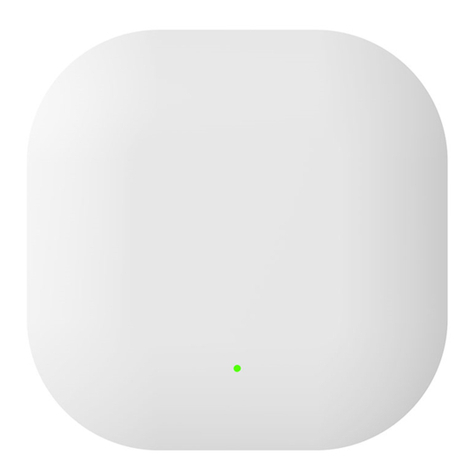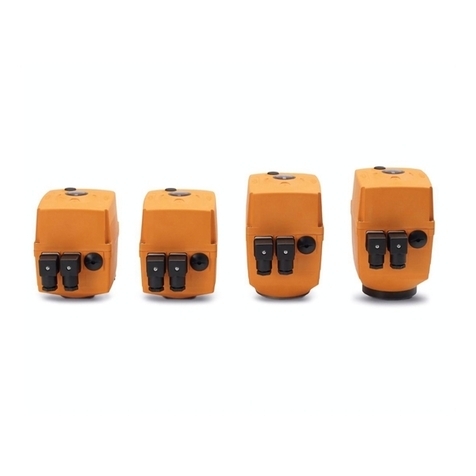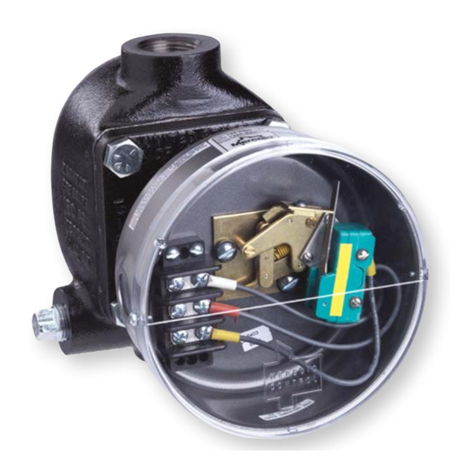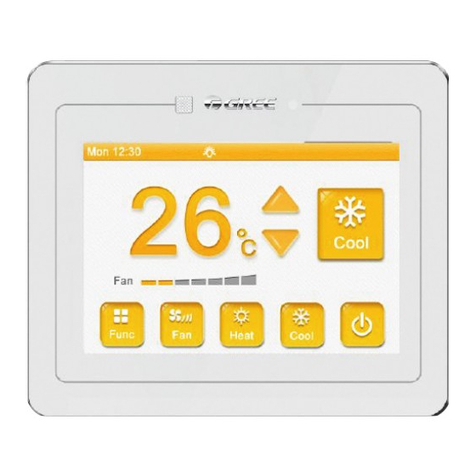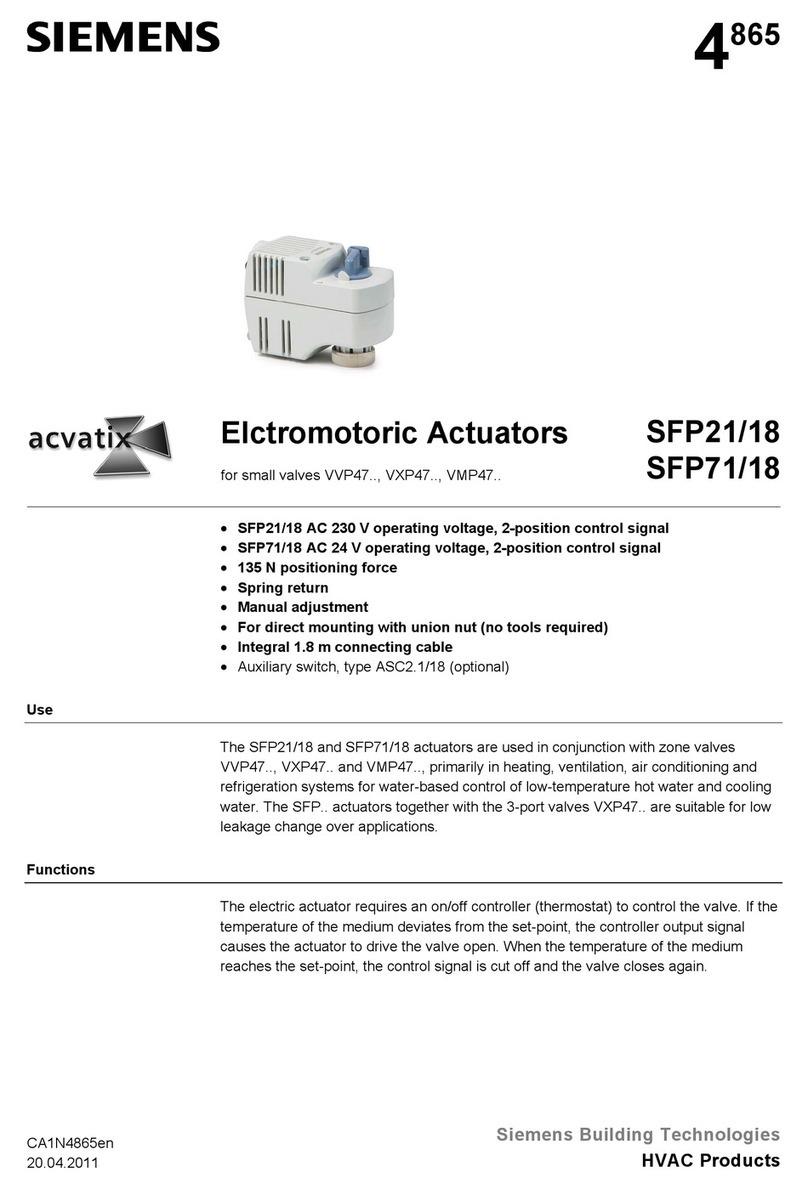Preferred Instruments PCC-IV User manual

PCC-IV Controller
Instruction Manual
Revision 0.2
Preferred Instruments
A Division of Preferred Utilities Mfg. Corp.
31-35 South St., Danbury, CT 06810
Ph: 203-743-6741 Fax: 203-798-7313
preferred-mfg.com

PCC-IV Instruction Manual (rev. 0.2) Page ii
WARNING
The PCC-IV is commonly used to control potentially dangerous combustion and chemical
processes.
Only qualified instrument engineers or senior technicians that have read this entire manual,
and are familiar with all aspects of the process being controlled should attempt to re-
configure the blockware control logic contained in the memory of a PCC-IV Controller.
VERIFY THAT THE PROCESS BEING CONTROLLED HAS BEEN SAFELY SECURED,
ISOLATED, OR BYPASSED (AS REQUIRED BY THE SITE CONDITIONS) BEFORE MODIFYING
ANY OF THE BLOCKWARE DATA IN ANY BLOCK IN THE PCC-IV MEMORY.
FAILURE TO DO SO CAN RESULT IN EQUIPMENT DAMAGE, INJURY, OR DEATH.

PCC-IV Instruction Manual (rev. 0.2) Page iii

PCC-IV Instruction Manual (rev. 0.2) Page iv

PCC-IV Instruction Manual (rev. 0.2) Page v

PCC-IV Instruction Manual (rev. 0.2) Page vi

PCC-IV Instruction Manual (rev. 0.2) Page vii
Revision History:
Revision 0.1 –10/20/2017
•Added PUMC logo to each page
•Minor grammar/format changes throughout
•Corrected error in description of alarm annunciator screen
Revision 0.2 –01/22/2018
•Updated Section 5 to latest PC4_Draw
•Stated that 24 Vdc power supply wiring should be shielded twisted pair.

PCC-IV Instruction Manual (rev. 0.2) Page viii
INTRODUCTION
The PCC-IV represents the next generation of digital controllers. As a programmable logic relay, it
maintains all the advantages of single or multiple loop controllers while addressing many of the features
of PLCs and DCS I/O modules.
The mounting depth (will fit in 8” deep panels); NEMA 13 splash proof front panel; standard RS-485
communications facility (Modbus protocol); Ethernet Modbus protocol; and USB/laptop and front panel
configuration capabilities are clear differences between itself and its competitors. The PCC-IV has
retained and enhanced many of the features that customers have come to appreciate about our digital
controllers… “Service Manual”, “Learn” function, “Boiler Efficiency” function, Oxygen
Sensor/Temperature Controller, O2 signal conversion option card, and many others.
It is the flexibility of the PCC-IV, not simply as measured by its ability to function without its front panel,
but more importantly its I/O expansion capabilities and the significant number of choices available for
expansion, that render the PCC-IV an unparalleled choice for most control applications. Consider that
each PCC-IV CPU board has two expansion board slots that accept any of the available option cards
(Note: a third slot is available but is dedicated for use with only one type of option card). Consider
further that there are option cards which can perform the following:
•Control the temperature of oxygen sensors and convert their millivolt outputs to signals useful
for control and/or monitoring applications
•Accept both analog and digital signals as inputs and outputs in many combinations
•Accept up to 6 isolated analog inputs, control up to 5 triac device pairs, or control up to 6 relay
outputs
As noted, the ability to install the PCC-IV CPU board alone (i.e. less front panel), with or without any of
the combination boards mentioned above, further enhance data acquisition and control capabilities.
The PCC-IV is designed with all new modern components, including a color touchscreen interface, faster
processor, more (and longer-lasting) memory, more block capacity, and modern Ethernet networking
capabilities. The new PC4_Draw programming software is .NET based and is Windows 10 compatible
and does not use the obsolete Visio program.
Replacing a PCC-III with a PCC-IV is easy. The new loop controller fits in the same cutout as the PCC-III,
and it uses the same expansion boards. Terminal blocks are the same, no field wiring changes are
required. You can use PC3_Edit to extract a program from an existing PCC-III. Then open the PC3_Edit
file in PC4_Draw to convert the program and download the new program into the PCC-IV. The PCC-IV
runs off external 24VDC power but still has the same PCC-III 120Vac I/O.
So, as you read this manual, be sure that you are clear about the vast capabilities of the PCC-IV. It is
simply not just another digital controller.

PCC-IV Instruction Manual (rev. 0.1) Page 1-1 Section 1 -Product Overview
Section 1 – PRODUCT OVERVIEW
Table of Contents
Product Description................................................... 2
Features.................................................................... 2
Benefits..................................................................... 2
Distributed Control System Concepts........................ 3
Analog and Discrete Control Functions..................... 3
Configuration Concepts............................................. 3
Com-Link Data Highway Concepts ........................... 3
Blockware Concepts.................................................. 4
Blocks .................................................................4
Library of Functions.............................................4
Any-Function-Any-Block......................................4
Reusable Functions ............................................4
Softwiring ............................................................4
Special Option Card and Special Function Block
Capabilities................................................................ 4
Multiple F(x) ........................................................5
Learn Mode.........................................................5
Boiler Efficiency...................................................5
Triac Output for Electric Actuators (option cards)5
Service Manual and Block Forcing......................5
Steam Flow Pressure Compensation..................5
Gas Flow Pressure/Temperature Compensation 5
High-Temperature Hot-Water (HTHW) BTU/Hr
Computation .......................................................5
Drum Level Pressure Vs. Density Compensation
............................................................................6
Oxygen Sensor Control/Signal Conversion
(option card)........................................................6
Relay Output Channels.......................................6
Flow Totalization.................................................6
PCC IV Loop Controller Model Number.....................7
Option Board Input / Output Expansion Examples:....7
Spare Parts List .........................................................8
PCC-IV Specifications................................................9
Mechanical:.........................................................9
Environmental:....................................................9
Performance:......................................................9
Operator Control Panel:......................................9
Electrical:............................................................9
Input/output (Standard –no option cards):..........9
Communications.................................................9

PCC-IV Instruction Manual (rev. 0.1) Page 1-2 Section 1 -Product Overview
Product Description
This section overviews the many PCC-IV features which address the requirements of both data acquisition and
control applications. The PCC-IV is designed to address the needs of most process control applications, and that
design has been further optimized to meet the exacting needs of combustion control systems.
Features
Benefits
Multiple Loops
Allows cost effective control of more than one
process loop in a single controller.
Service Manual
Allows manual control in the event of memory,
CPU, or digital circuitry failure.
Redundant Memories
Allows for self-recovery in the event of a primary
memory error.
Optically Isolated Data Highway
Safe/reliable communication that prevents a single
controller failure from disrupting an entire network.
Redundant RS-485 communications are available
as an option.
Engineering Units Display Flexibility
Allows the operator to view up to 10 process
variables each with process (tag) descriptions.
Local Parameter Configuration
Allows front panel parameter configuration without
the need for a special configurator or laptop
computer. Note: two, standard micro-USB ports
allows laptop blockware configuration.
Ten-point (“first in-first out”) Alarming
Allows the operator to view the order of alarms and
acknowledge each separately.
“Learn” Function
Allows for easy entry of complex function curves
without prerequisite data collection.
Industry standard communications
Allows the controller to be used in any system
and/or with others hardware/software which
communicate via Modbus protocol (RS-485 and/or
Ethernet).
Optional I/O Cards
Allows significant Discrete and Analog I/O
expansion capabilities within a single controller.
Self-supporting CPU Board
The controller’s CPU board is fully functional
without the front panel, allowing for further I/O
expansion alternatives.
Easy PCC-III Upgrade
With the addition of an external 24 VDC power
supply, the PCC-IV can be installed in the same
location as a PCC-III. The PCC-IV field wiring
terminals are physically and electrically identical to
the PCC-III. CPU board analog input 250 ohm
jumpers are in the same locations as in the PCC-
III. The same Option Boards are used. The PCC-
IV can use the same program with a simple
PC4_Draw automatic conversion.

PCC-IV Instruction Manual (rev. 0.1) Page 1-3 Section 1 -Product Overview
Distributed Control System Concepts
The PCC-IV represents the fourth generation of process controllers from Preferred Instruments. This controller is
designed to provide a true distributed approach to control applications. The PCC-IV provides automation features
that are self-sufficient and will operate independently from the remainder of the control system. The PCC-IV can be
configured as a data collection I/O module (DCS-IV) for a data acquisition system, as a multi-loop controller, or as
a traditional single loop controller. In all cases the PCC-IV will communicate on a network with a central operator’s
station using the industry standard Modbus protocol.
Because the PCC-IV is self-sufficient, control will be maintained even if for any reason, the operator’s station(s) or
network are completely disabled. Un-like a PLC, a single PCC-IV or DCS-IV failure affects a relatively small
percentage of the overall system’s I/O. Considering all the above, the need for redundant power supplies,
microprocessor cards, or I/O cards is greatly reduced.
The backbone of the system is the network. The network used between controllers is based upon the industry-
standard Modbus protocol, using the controller’s integral RS-485 and Ethernet communications ability. This network
communication is optically isolated.
Analog and Discrete Control Functions
The PCC-IV includes all the control functions needed for your application. The controller includes not only traditional
analog functions but also many discrete (logical) and timing functions. The controller can handle many tasks that
would normally require the use of a PLC, and the use of option cards permits expansion of those discrete I/O
capabilities (up to 13 DI and 10 RO/DO). Discrete functions can also be readily integrated with analog functions
which has been traditionally difficult to accomplish with a PLC, due to its purely logical basis. The combination of
integral analog, discrete, and timing functions renders the PCC-IV a very powerful control solution.
Configuration Concepts
In many applications, the PCC-IV is shipped with a standard factory configuration, but it is designed to permit easy
modification or development of control strategies in the field. The PCC-IV can modify parameters using front panel
touchscreen display. Any Windows computer can configure the logic graphically with the PC4_Draw software. The
PCC-IV USB port allows PC4_Draw to monitor live data, change any parameter, and read/write entire function block
configurations and provides full documentation capabilities.
Com-Link Data Highway Concepts
The PCC-IV can be networked together over an industry standard Modbus network (RS485, or Ethernet Modbus
TCP/IP). Modbus is an open architecture format to allow flexibility for future system expansion and/or modification.
The RS485 and Ethernet networks are electrically isolated controller-controller, and controllers-SCADA. The RS485
network allows controllers to be located up to 4000 feet apart, and up to 31 controllers (plus the Master) can be
networked. The use of Modbus as a communications protocol allows the PCC-IV to be integrated with other’s
equipment and on networks supplied by ourselves or others.

PCC-IV Instruction Manual (rev. 0.1) Page 1-4 Section 1 -Product Overview
Blockware Concepts
The PCC-IV makes use of Blockware (aka Function Blocks) which makes control strategy configuration easy. In
Section 5, we will discuss Blockware and configuration in greater detail, but the basic elements that make up
Blockware are as follows:
Blocks
The PCC IV memory is made up of blocks. Each block is a container into which a Blockware Function is placed.
Think of a block as a “cell” in an Excel spreadsheet, you put a formula or a function into a cell, and the formula uses
the values from other cells as inputs for the formulas. The controller includes sufficient memory to handle 256
blocks.
Library of Functions
The PCC-IV has an extensive library of Functions to handle any type of control task. These Functions are identified
and described in detail in Section 6 of this manual. The library includes Functions for the conversion of inputs to
engineering values, mathematical operations, logical operations, timing operations, the traditional PID algorithm,
and other types of special PID Functions. Additional special Functions such as “Learn”, “Boiler Efficiency”, etc. are
included and are described in Section 6.
Any-Function-Any-Block
Each block is assigned a Function-type during configuration. Any Function-type can be used in any block number.
The block number only determines the order in which the blocks are calculated. In the example below at left, Block
number 22 is not being used, so it has the default NOP, or “No OPeration” Function in it. At right, Block 22 was
changed from a NOP to a HIALM (high alarm) Function type.
Reusable Functions
Almost all PCC IV Function-types can be used as many times as required, within the 256-block limit. There are
some Functions that are directly linked to the hardware that can only be used as many times as there is mating
hardware. For example, only one PANEL Function (Front Panel Display Interface) can be used because there is
only one front panel. While those related to PID Functions, curve fitting Functions, etc. can be used as many times
as is deemed necessary for the application.
Softwiring
Most Function-types, like HIALM, need information from other sources (i.e., blocks) to calculate a result. Softwiring
is the term used to describe how the blocks are interconnected within the software. Softwiring allows the input of a
block to monitor the output of any other block. At right below, the PV (Process Variable) input of Block 22 (HIALM)
is monitoring the output of Block 20 (AIN), via a softwiring connection.

PCC-IV Instruction Manual (rev. 0.1) Page 1-5 Section 1 -Product Overview
Special Option Card and Special Function Block Capabilities
The following are applications features of the PCC-IV which extend its capabilities considerably:
Multiple F(x)
The F(x) function-type allows for “characterizing” or “curve fitting” of a relationship when that relationship is non-
linear. In combustion control applications, as an example, it is desirable to have the fuel input to a burner follow a
linear relation with firing rate demand. Even with a properly selected valve trim, the relationship will not be perfectly
linear, but with the application of an F(x) block, this objective can be realized. The PCC-IV has the capacity to use
as many F(x) functions as are required by the application.
Learn Mode
The learn mode allows for easy commissioning of applications involving single or multiple non-linear functions. This
capability is best described with an example. In combustion control applications, as the firing rate is increased, the
best combustion air damper position will likely not be a linear function. An F(x) block can be used to effectively
linearize the combustion air flow vs. firing rate relationship. F(x) blocks will likely be required for the fuel-valve-
degree-of-opening demand signal and the oxygen setpoint (if O2Trim is provided). The clear benefit of the learn
mode is that at each of the F(x) block data points, after optimum conditions are set by the technician, he/she simply
presses the “Learn” button for the PCC-IV to remember (learn) the current firing rate vs. valve and damper positions
and oxygen setpoint relationships simultaneously. The technician then proceeds in a similar fashion up to full firing
rate, repeating this procedure at each point. This results in a considerable savings in commissioning time and an
optimally characterized process.
Boiler Efficiency
The boiler efficiency function allows the controller to calculate, in real time, the boiler’s efficiency and display that
result on the controller’s front panel (and/or a recorder or a Data Acquisition terminal). Boiler efficiency is calculated
using the ASME “by losses” method. This function requires inputs of flue gas temperature, combustion (ambient)
air temperature, percent oxygen in the flue gas, and percent firing rate (for radiation loss determination) to evaluate
the efficiency. This function is not only useful for establishing on-line fired equipment efficiency, but also allows
determination of changes in that efficiency and therefore the potential for maintenance.
Triac Output for Electric Actuators (option cards)
Many systems utilize electric actuators where a bi-directional on-off voltage signal is used to drive the actuator open
or closed. The PCC-IV has the optional interface electronics to accomplish this control action. Additionally, the Triac
Output option card(s) include position feedback input provisions for optimizing control of actuator position.
Service Manual and Block Forcing
In Service Manual mode, controller 4-20mA outputs and/or servo Triac Outputs can be manually controlled from
the faceplate, and the associated logic is overridden. Individual outputs, or all outputs can be placed in Service
Manual mode. Service Manual is useful for initial process or burner setup and to manually operate a unit in the
event a critical sensor, transmitter, or wiring fault occurs.
With a password, any block output can be forced to any value. This is useful for technician-level debugging and
operation until a transmitter is repaired/replaced.
Steam Flow Pressure Compensation
Accurate steam flow measurements are very important to the control and monitoring of process systems. Even
though most control systems are designed to assure a constant pressure, variations and/or upsets can occur, which,
if unaccounted for, can render records erroneous and produce unacceptable instabilities in all control loops upon
which this measurement depends.
Gas Flow Pressure/Temperature Compensation
Most gas flow measurements require some level of pressure and/or temperature compensation. This becomes
important when the flow measurement is a significant process control variable as it is in a “fully metered” combustion
control strategy.
High-Temperature Hot-Water (HTHW) BTU/Hr Computation
An important characteristic of any high-temperature, hot-water generator is the quantity of BTU’s produced per
interval of time. With inputs of the generator’s inlet and outlet water temperatures and the water’s flow rate, this
value can be easily calculated. The resultant value is typically compared to that from the boiler efficiency calculation
to determine if possible problems have arisen.

PCC-IV Instruction Manual (rev. 0.1) Page 1-6 Section 1 -Product Overview
Drum Level Pressure Vs. Density Compensation
In applications where there are large swings in steam demand, the steam generator’s drum level can be subjected
to significant shrink and swell. Density compensation is an important tool in assuring optimum drum level control
despite these conditions.
Oxygen Sensor Control/Signal Conversion (option card)
Zirconium oxide “in situ” oxygen analyzers include a basic electronics package that maintains sensor temperatures
at exacting levels and converts the millivolt output of the sensor into a linear “O2vs. milliamp” function (4-20 mA
dc). When equipped with the appropriate option card, the PCC-IV performs the same function as the manufacture’s
electronics package, while coincidentally allowing for the automatic integration of that variable into any planned
control or monitoring strategy.
Relay Output Channels
The PCC-IV can be equipped with up to 6 relay outputs. The relay contacts are rated for up to 8A inductive loads
and include integral surge suppressors for extended contact life. These outputs can be directly wired into most
burner limit circuits without external “helper” relays.
Flow Totalization
The PCC-IV is equipped with a pulse counter function-type to permit output and subsequent totalization of flow
rates on digital displays. This can eliminate the need for local counters on flow meters in those instances when they
already transmit an analog flow signal to the PCC-IV.

PCC-IV Instruction Manual (rev. 0.1) Page 1-7 Section 1 -Product Overview
PCC IV Loop Controller Model Number
PCC IV -a b c 0
Option Card Slot Number 1
0
none
A
AIN 5 ch. 4-20 mA / 0-5 VDC
B
IAIN 3 ch. Isolated 4-20 mA / 0-5 VDC
F
AIN 3 ch. 4-20 mA / 0-5 VDC
AOUT 2 ch. 4-20 mA Combination Board
G
TOUT 2 pair Triac Outputs, 2A 24-120 VAC
AIN 2 ch. Pot / 0-5 VDC / 4-20 mA Combination Board
J
DIN 4 ch. 120 VAC, Optically-Isolated
ROUT 2 ch. Relay Contact, 8A Inductive Combination Board
Z
ZrO2 Oxygen Analyzer Amplifier and Temperature Controller
R
Redundant RS-485 Communications, Optically isolated (Slot 1 only)
Option Card Slot Number 2
Select card type from the “Slot 1” list above
Option Card Slot Number 3
0
none
S
TOUT 1 pair Triac Outputs, 2A, 24-120 VAC
Option Board Input / Output Expansion Examples:
PCC IV Model Number
4-20 mA
0-5 VDC
AIN
4-20 mA
AOUT
120 VAC
DIN
8A
(relay)
ROUT
2A
(Triac pairs)
TOUT
200 mA
(sinking)
DOUT
Total
I/O
PCC-IV- 0 0 0 0
5
2
5
2
0
4
18
PCC-IV- A A 0 0
15
2
5
2
0
4
28
PCC-IV- F F 0 0
11
6
5
2
0
4
28
PCC-IV- J J 0 0
5
2
13
6
0
4
30
PCC-IV- G G S 0
9
2
5
2
5
4
27
PCC-IV- F G S 0
10
4
5
2
3
4
28
PCC-IV- A J 0 0
10
2
9
4
0
4
29
Note: The examples given in no way reflect the number of possible option card possibilities. The PCC-IV has a total
of three (3) option card slots, of which one is designated for use by the “S” card only. The remaining two slots can
house any of the remaining option cards in any desired combination. Please refer to Section 2 to establish the total
24 VDC power supply requirements.

PCC-IV Instruction Manual (rev. 0.1) Page 1-8 Section 1 -Product Overview
Preferred Instruments
PCC-IV Controller
Spare Parts List
Part Number
Description
Recommended
spares per 10
PCC-IVs
PCC-IV-0000
Complete PCC IV controller, with case & mounting brackets
0.5
92703
Main power fuse, 1.6A slow-blow
2.0
92705
Cable, 6.5 ft., USB-A to Micro USB-B
92443
24Vdc/2.5A DIN rail mounted power supply
99663
Micro-SDHC Memory Card, 8 GB with Case and Adapter
99659
USB programmer for SD cards
190801-PANEL
Front Panel, complete, includes: Bezel w/ gasket, touchscreen, USB
cable, screw, nameplate
0.5
90137
Front Panel screw with integral O-ring
90415
Bezel w/ Gasket (Set)
90416
Touch Screen Retaining Plate
94309
TFT LCD
19708F
Preferred Instruments nameplate for Front Panel, Alum
92492
Cable, 1.6 ft., USB-A to Micro USB-B
Available Spare Parts:
190800
CPU board
92491
2 pt. 24 Vdc power connector
92204
8 pt. field wiring connector
92223
14 pt. field wiring connector
92076
Slide-on jumper (250 ohm & R/W)
2759-006A-08C
CPU to case retainer screw, 6-32 x 1/2
92707
Cable, 9.8 ft., USB Extension Cable, A-Male to A-Female
190348
Case for panel mounting with rear cover (190347 panel mounting
brackets not included)
90134
Case to panel gasket
190347
Panel Mounting Bracket Kit (2 brackets/kit)
190319
1 pair Triac output option board (slot 3 only)
92245
5 pt. field wiring connector
92247
fuse, 3 A, fast acting
190361
5 ch. 4-20 mA / 0-5 VDC AIN option board
92243
12 pt. field wiring connector
190362
3 ch. 4-20 mA / 0-5 VDC isolated AIN option board
92251
6 pt. field wiring connector
190366
3 ch. 4-20 mA / 0-5 VDC AIN, 2 ch. 4-20 mA AOUT combination option
board
92243
12 pt. field wiring connector
190367
2 ch. 0-5 VDC / pot AIN, 2 pair 3A 24-120 VAC TOUT (Triac)
combination option board
92243
12 pt. field wiring connector
190370
4 ch. 120 VAC opto-isolated DIN, 2 ch. 8 A ROUT (Relay) combination
option board
92243
12 pt. field wiring connector
25250-0B25-
3/4MF
250.0 Ohm Precision Resistor
PC4_Draw
Windows PC-based Blockware design and maintenance software

PCC-IV Instruction Manual (rev. 0.1) Page 1-9 Section 1 -Product Overview
PCC-IV Specifications
Mechanical:
Case Size: Height: 7.38”; Width: 3.00”; Depth: 7.75”
Enclosure Type: Flush panel mounted
Front Panel Size: 8.00” H X 3.75” W
Panel Cutout: 7.50” H X 3.13” W (+/-.062)
Weight: 6 lbs. (excluding option boards)
Environmental:
Operating Temp: 32 to 122oF (0 to 50oC)
Storage Temp: -20 to 150oF (-28 to 65oC)
Humidity Limits: 15 to 95% (non-condensing)
Front Panel: NEMA 13, IP65
Performance:
Accuracy: 0.025% Analog Inputs and Outputs, 70 F
Resolution: 16-bit input / 16-bit output
Execution Cycle: Ten per second
Retentive Memory Life: 40-50 yrs., MRAM, no batteries, non-EEPROM
Operator Control Panel:
Display: Backlit TFT LCD display showing current display loop and variable
Bar graphs: Process Variable, Setpoint, and Output displayed
Touchscreen-based Pushbuttons: Display Select, Alarm acknowledge, Setpoint adjustment, 4 user-defined,
configurable buttons
Faceplate: Splash proof
Alarm Annunciator: 10 Point, First out, Time/Date Stamped
Status Indicators: 8 (6 Configurable)
Real-time Clock Powered by super-cap, no batteries, keeps time for 8+ days after being
powered down
Electrical:
Input Power Requirements: 24 Vdc (+/- 15%), 450mA, 10.5 VA (CPU board with faceplate, no option
boards or field loads). See Section 2 to calculate additional 24Vdc load due to
option boards and field device loads.
1.6A/24Vdc Input fuse, 1.1A max total load (recommended)
Input/output (Standard –no option cards):
Analog Inputs: Quantity: 5
Type: 4-20 ma DC; 0-5 VDC
Analog Outputs: Quantity: 2
Type: 4-20 ma DC, 800-ohm load
Discrete Inputs: Quantity: 5
Type: 120 VAC opto-isolated
Discrete Outputs: Quantity: 6
Type: (2) SPDT relay contact, 8A, 120V; ½ HP @ 120 VAC
(4) Open Collector (sinking), 24 VDC, 200Ma
I/O Expansion: See Table Above
Communications
Network: Protocol: Modbus (ASCII, RTU, or TCP/IP mode)
Speed: 4800-115,200 baud
Type: RS-485 (optically isolated) or Ethernet
Configuration: Type: Micro-USB connector
Specifications subject to change without notice.

PCC-IV Instruction Manual (rev. 0.2) Page 2-1 Section 2 - Installation
Section 2: Installation
Table of contents
Option Board Descriptions ..........................................2
Mounting Overview......................................................2
NEMA 13 / IP65 Environment .....................................2
Ambient Temperature..................................................2
Rear Access................................................................2
Mounting .....................................................................3
PCC-IV Dimensions ................................................3
Panel Cutout Dimensions........................................3
Wiring Overview..........................................................4
120 Vac Ground......................................................4
Terminal Blocks.......................................................4
Wire Type................................................................4
Shielded Cable........................................................4
24 Vdc Redundant Power Input Terminals..................4
Connecting and Powering the Front Panel..................5
24 Vdc & 5 Vdc Power Supply Load Calculations.......6
Fuses ..........................................................................6
250-ohm Resistors for 4-20 mA Inputs........................7
“A” Option Board 250-ohm Switches.......................8
Rev. 0: “B” Option Board, 250-ohm Switches..........8
Rev. A: “B” Option Board, 250-ohm Switches .........8
“F” Option Board 250-ohm Switches.......................9
“G” Option Board Fuses and Pull-ups .....................9
“J” Option Board Isolated Neutral Jumpers ...........10
“S” Option Board 120 Vac Fuse ............................10
CPU Board Layout ................................................11
CPU Board Field Wiring Terminals............................12
Option Board Field Wiring Terminals.........................13
Wiring Examples .......................................................14
Two Wire 4-20 mA Input, Internal 24 Vdc.............14
Two Wire 4-20 mA Input, External 24 Vdc.............14
Four Wire 4-20 mA Input.......................................14
Isolated 4-20 mA Input ..........................................15
1-5 Vdc Input.........................................................15
0-10 Vdc Input.......................................................15
Potentiometer Input...............................................16
Potentiometer Input, “G” Board .............................16
4-20 mA Output.....................................................16
120 Vac Discrete Inputs, CPU Board ....................17
120 Vac Discrete Inputs, “J” Board........................17
Relay Output .........................................................18
Discrete Output, Sinking, Internal 24 Vdc..............18
Discrete Output, Sinking, External 24 Vdc.............18
Triac Output, Reversible Actuator .........................19
Triac Output, Other AC Loads...............................19
DC Commons and AC Neutrals Isolation ..................20
Pull-Up/Down Resistor for Voltage Inputs .................22
RS485 Communications Wiring.................................23
Ethernet Cables.........................................................25
Micro-USB Download Cable......................................25
Field Installation of Option Boards.............................26

PCC-IV Instruction Manual (rev. 0.2) Page 2-2 Section 2 - Installation
Option Board Descriptions
Option Board Slot 1 or Slot 2
A
AIN 5 ch. 4-20 mA / 0-5 Vdc
B
IAIN 3 ch. Isolated 4-20 mA / 0-5 Vdc
F
AIN 3 ch. 4-20 mA / 0-5 Vdc
AOUT 2 ch. 4-20 mA Combination Board
G
TOUT 2 pair Triac Outputs, 2A 24-120 Vac
AIN 2 ch. Pot / 0-5 Vdc / 4-20 mA Combination Board
J
DIN 4 ch. 120 Vac, Optically-Isolated
ROUT 2 ch. Relay Contact, 8A Inductive Combination Board
Z
AIN 3 ch. mV, Optically-Isolated ZP Oxygen Analyzer
TOUT 1 ch. Triac Outputs, 2A, 120 Vac Combination Board
Note: The 'Z' Option Board is described in the ZP Oxygen Analyzer Manual, it is NOT covered by this Manual.
Option Board Slot 3
S
TOUT 1 pair Triac Outputs, 2A, 24-120 Vac
Mounting Overview
PCC-IV is designed for flush mounting in an enclosure in a NEMA 13 (IP65) indoor environment. Continuous
operation is guaranteed over the 32-125 F (0-52 C) ambient temperature range without derating. The controller
should not be subjected to excessive vibration. The PCC-IV is UL508 recognized for NEMA 1 dry indoor
applications. The NEMA13 rating is based on Preferred Instruments testing and is not third party UL508 recognized.
NEMA 13 / IP65 Environment
A NEMA 13 environment is generally defined as: Intended for indoor use primarily to provide a degree of protection
against dust, and splashed or sprayed water, oil, or non-corrosive coolant. NEMA 13 is generally equivalent to the
European IEC standard IP65.
The PCC-IV front panel and case gasket will provide NEMA 13 protection if the enclosure to which the PCC-IV is
mounted itself is designed for NEMA 13 (minimum) protection.
PCC-IV can be installed in more severe environments if the user provides additional protection that is consistent
with and/or required for the area’s rating.
Ambient Temperature
PCC-IV is rated for continuous operation over the 32-125 F (0-52 C) ambient temperature range without derating.
A typical PCC-IV installation (in a control cabinet mounted next to an industrial packaged boiler) would not require
cabinet cooling. However, each installation should be evaluated individually to determine if the PCC-IV ambient
temperature (i.e., the control cabinet internal temperature) will exceed 125 F.
The control cabinet internal temperature is a function of the outside air temperature, the surface area of the control
cabinet, and the amount of heat released by other components inside the cabinet. A PCC-IV consumes
12 VA worst case, therefore, it releases a maximum of 75 Btu/hr. The major control cabinetmanufacturers (Hoffman,
Hammond, …) include information in their catalogs to help calculate cabinet internal temperature rise (with and
without various cooling methods).
Rear Access
The PCC-IV case is 7 ¾ deep behind the mounting flange; therefore, PCC-IV can be mounted in 8” or deeper
control cabinets. All field wiring connections are located behind a cover plate in the rear of the controller. Rear
access is requiredfor installation, calibration, and troubleshooting. Routine operation is accomplishedfrom the front
of the controller. Control strategy Blockware downloading/uploading is accomplished from either the front or the
back of the controller, as desired, based on the position of the USB programming port select jumpers, JP2 (Pins 1-
3 & 2-4 for the front jack –Pins 3-5 & 4-6 for the rear jack).

PCC-IV Instruction Manual (rev. 0.2) Page 2-3 Section 2 - Installation
Mounting
Refer to the PCC-IV Mounting and Panel Cutout Dimension drawings that follow. Cut the hole in the enclosure.
Remove any burrs and loose metal chips. Remove the Panel Mounting Brackets from the PCC-IV case. Slide the
PCC-IV into the hole. From the rear of the PCC-IV, slide the Mounting Brackets tabs into the slots in the PCC-IV
case. Using a 1/8” Allen wrench, tighten each mounting bracket screw against the enclosure.
Additional Mounting Brackets can be ordered as part number 190347, if the mounting brackets supplied with the
PCC-IV are lost or damaged.
PCC-IV Dimensions
(inches)
Panel Cutout Dimensions
and Minimum Spacing (inches)
3.13
7.50
.63 min
1.75"
min
3.75
7.75
1.13
1.13
3
.5
.5 max
.88
.75
7.38
8
Gasket
Flange
Gasket
1/8" hex socket
3/4" conduit K.O.
1/2" Conduit K.O.
3/4" Conduit K.O.
Removable
Rear Cover
Field Wiring
Terminal
Blocks
Located Inside
Table of contents
Popular Controllers manuals by other brands
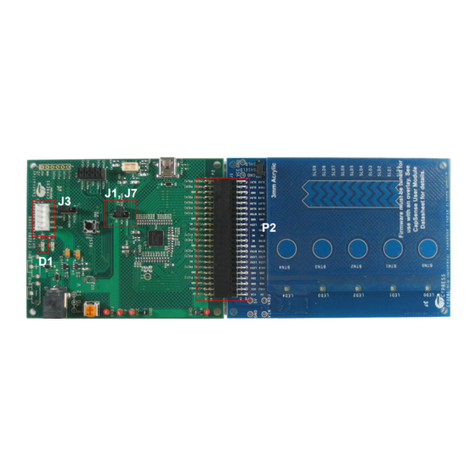
Cypress
Cypress CY3280-20x66 Universal CapSense Guide
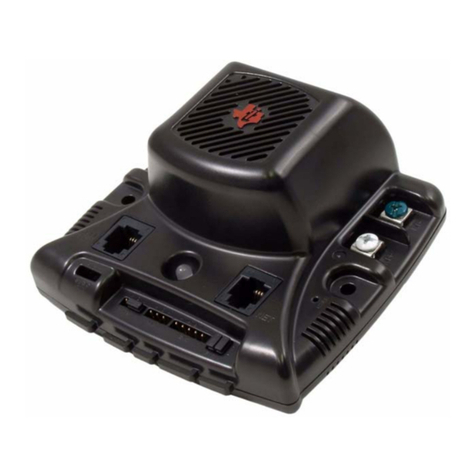
Texas Instruments
Texas Instruments Stellaris MDL-BDC24 Getting started guide
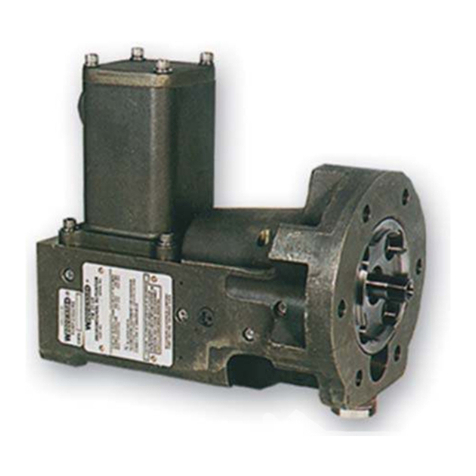
Woodward
Woodward TM-25LP Installation and operation manual
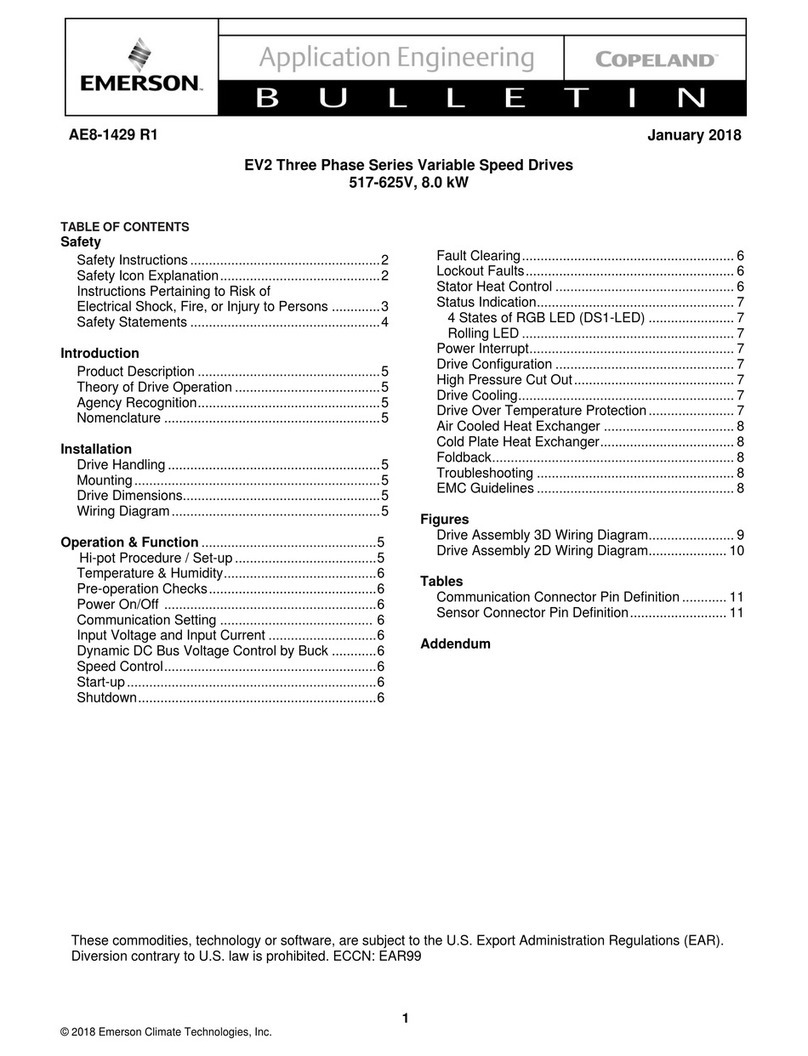
Emerson
Emerson Copeland EV2 Series Application Engineering Bulletin

TOA-DKK
TOA-DKK MBM-102A Operator's manual

Samson
Samson 3730-2 quick guide
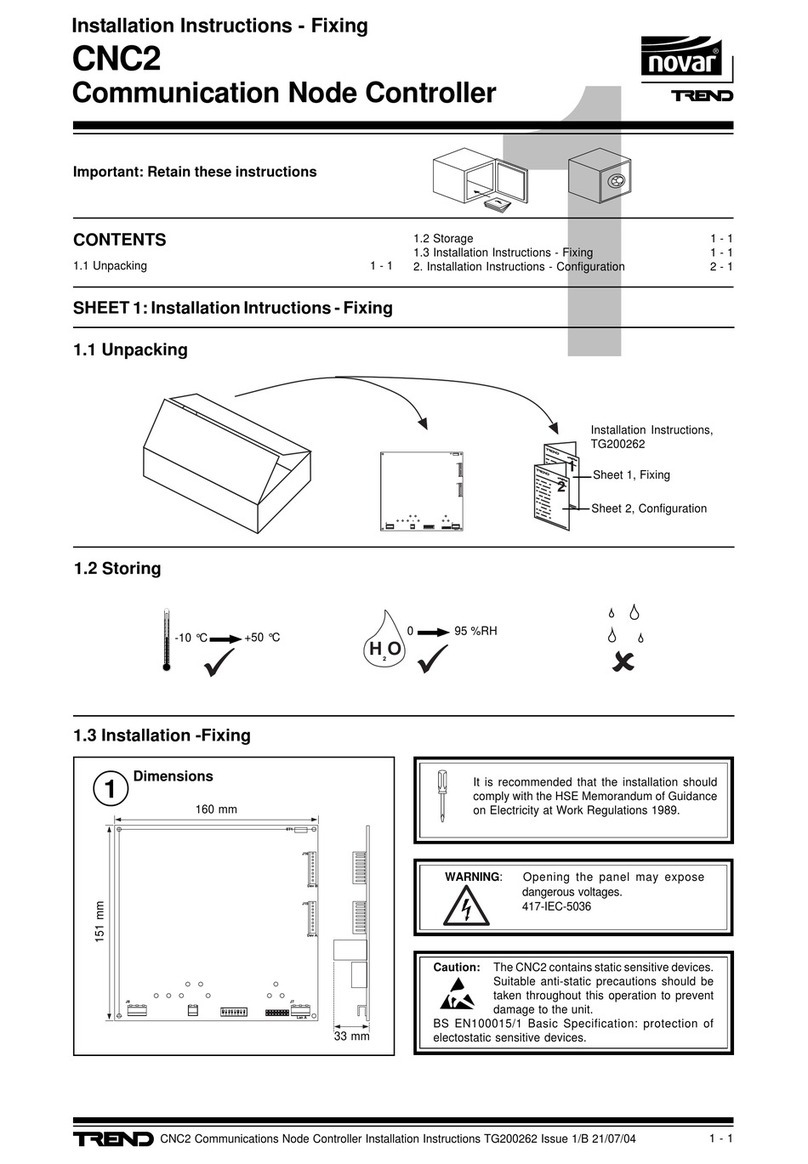
TREND
TREND CNC2 Installation Instructions - Fixing

Omron
Omron CS1G/H-CPUxx-H instructions
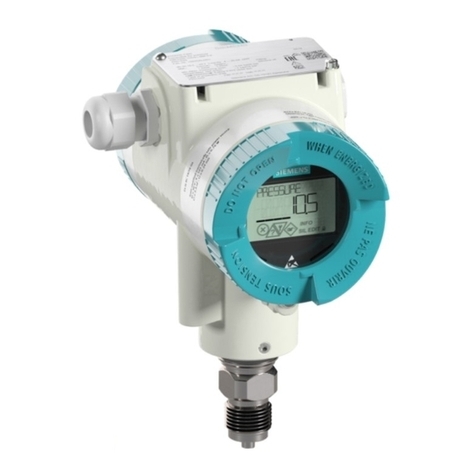
Siemens
Siemens SIMOTION Series Commissioning and hardware installation manual
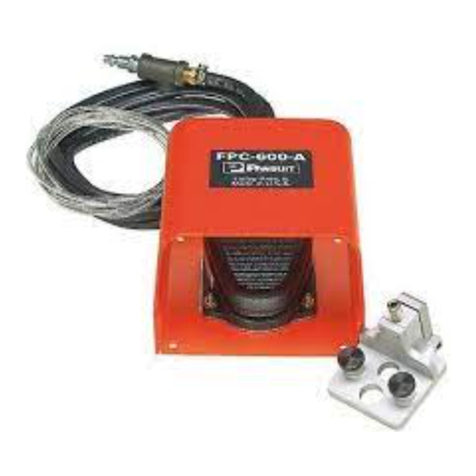
Panduit
Panduit FPC-600-A operating instructions
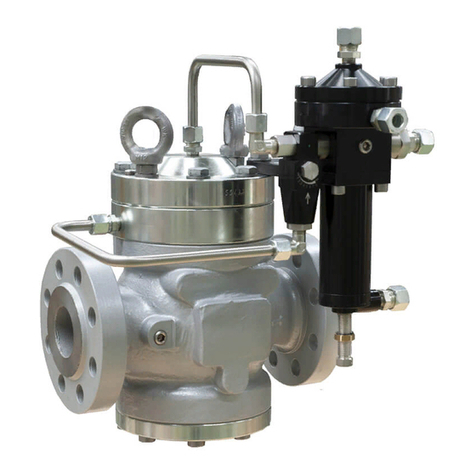
PIETRO FIORENTINI
PIETRO FIORENTINI APERFLUX 851 Installation, commissioning and maintenance instructions
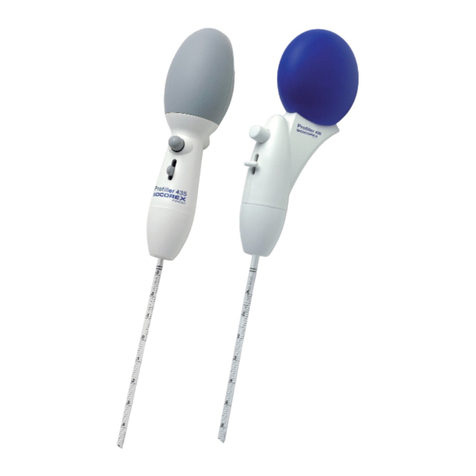
socorex
socorex PROFILLER 435 operating instructions
